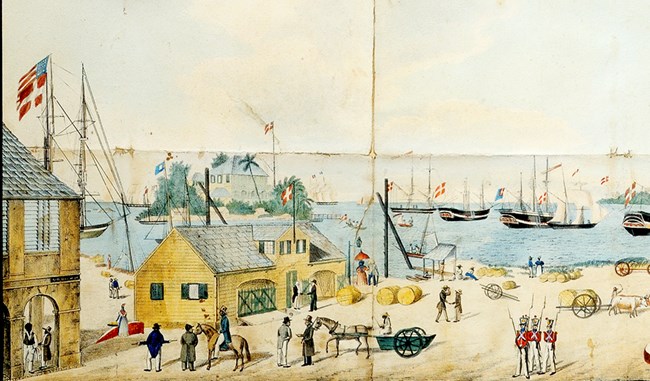
Image courtesy of the Danish Maritime Museum. The Port of Christiansted
The location of the first Danish settlement on St. Croix was selected due to the presence of a harbor suitable for trade and shipping, and that could be protected. The Danes built Christiansted on the ruins of a small port town first built by the Dutch in the 1640s, then enlarged by the English, then the French, for the same reason – the reef-protected harbor that could foster shipping and trade. The new town, named Christiansted (“Christian’s Place”) in honor of King Christian VI of Denmark-Norway, was envisioned to rival Christiania (later named Olso, Norway) in size.
St. Croix’s was first administered by the royally chartered slave-trading monopoly Danish West India and Guinea Company from 1734 to 1754. During this time the economy did not grow, and settlers were not arriving in droves. The Company overburdened planters and merchants with excessive taxes on imports and exports and required that all trade be carried in Danish vessels. In 1754 the Danish Crown purchased the Company’s stocks and took over the administration of Danish West Indies. The royal governor-general took up residence at the new capital, Christiansted. For the next 150 years the town’s success was tied to the success of the island’s sugar industry on the European and North American markets.
As the result of new policies that opened up trade, St. Croix’s population increased dramatically between 1760 and 1800, and great profits were realized. Commonly referred to as the “Golden Age,” this was a time of both great financial success and human travesty, as the wealth was generated based on the blood and toil of an enslaved population of nearly 50,000 men, women, and children.
The success of deriving sugar from beets during the Napoleonic Wars, a region-wide depression in the 1820s, the loss of slave labor with emancipation in 1848, and a succession of hurricanes and droughts all contributed to an irreversible economic decline.
Christiansted’s Danish colonial heritage can still be seen in its architecture and street names. Neoclassical government buildings and townhouses, churches that exhibit various national influences, combination shop-residences, and shingled wooden cottages blend to create a lasting impression of a West Indian colonial capital built on the trade in enslaved people, sugar, and rum. |
Last updated: August 10, 2017
